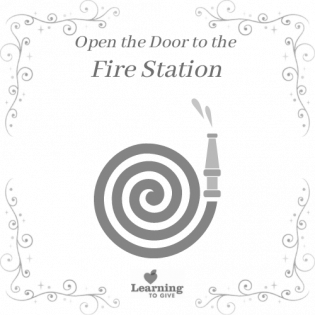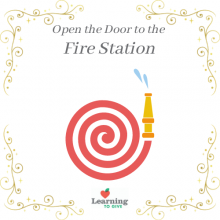Open the Door to the Fire Station
The "Open Doors to Your Community" project is a virtual door that guides young people to the actual door of local resources so they can learn about their community, take action, and build connections and understanding of their roles in the community.
What Is the Purpose of a Fire Station?
Every community has fires and other emergencies that require help from trained firefighters. Firefighters are trained to put out fires, rescue people, and assist in medical emergencies. They also have machines and an adequate water supply to put out fires. Without firefighters, people would have to put out fires themselves. Some communities have volunteer fire departments, and others hire career firefighters.Meet a Fire Fighter
In this brief video, we meet Chief Joe Cooper and Rachel Cooper. They share how firefighters do their jobs and how others can get involved as volunteers or in the cadet program for teens so they can work toward a career as a firefighter or medical professional.
Contact Your Local Fire Station
Look up the contact information for the fire station or public safety in your community where you can learn about how they handle fires and other emergencies. This may be a small volunteer fire department with trained volunteers or a fully staffed department with career firefighters. Call to set up a phone or in-person interview. Tell them you'd like to learn more about the work of the fire station and best practices so you can get involved or volunteer to help their mission. Ask for 30 minutes or an hour of their time. The Interview Script linked here and below can help you make the call.
Interview Questions
These questions can help you learn about your community and ways you can get involved.
- What is the main purpose of a fire department? This may be its mission or vision.
- What are some challenges that firefighters face? What are the different types of fires that occur? What other emergencies do you address?
- What are some things people can do to reduce the risk of fires?
- What can a young person do to participate in the community around a fire station?
Take Action in Your Community
Reflect on the work of the fire department. What can you help them do? Your voice and time matter. The resources below can help you plan a project.
The best service-learning projects guide us to gain and use knowledge, are led by youth voice and passion, address a need, and develop connections with local resources over time.
 Learning to Give Issue Area Toolkits include background on the issue, community connections, lessons and activities, project ideas, and planning guides. Check out the Crisis Prevention and Response toolkit.
Learning to Give Issue Area Toolkits include background on the issue, community connections, lessons and activities, project ideas, and planning guides. Check out the Crisis Prevention and Response toolkit.
 Learning to Give Service Sparks guides provide directions for generous actions that encourage youth voice and promote the common good. Young people can express gratitude to firefighters with the Gratitude Pen Pals service project. They can also promote fire safety by raising awareness of preventative actions using Advocacy Posters.
Learning to Give Service Sparks guides provide directions for generous actions that encourage youth voice and promote the common good. Young people can express gratitude to firefighters with the Gratitude Pen Pals service project. They can also promote fire safety by raising awareness of preventative actions using Advocacy Posters.
 Learning to Give Literature guides combine selected literature with thought-provoking discussions and activities that teach about giving and civic engagement. Read aloud a picture book to a younger child or a retirement home buddy and talk about the community themes. The picture book Circles Around Us explores the power of community and the difference we can make when we have the courage to open ourselves up to others. While not related to a fire, the book Humphrey the Lost Whale tells how a community came together in an emergency when a whale swam upriver and got stuck.
Learning to Give Literature guides combine selected literature with thought-provoking discussions and activities that teach about giving and civic engagement. Read aloud a picture book to a younger child or a retirement home buddy and talk about the community themes. The picture book Circles Around Us explores the power of community and the difference we can make when we have the courage to open ourselves up to others. While not related to a fire, the book Humphrey the Lost Whale tells how a community came together in an emergency when a whale swam upriver and got stuck.
More about Fire Departments and Fire Safety
Fun Facts:
- Benjamin Franklin established the first all-volunteer community fire company in Philadelphia in 1736.
- A firefighter needs a minimum of 100 hours of training before entering a burning building.
- The weight of firefighter gear averages 45 pounds, including boots, pants, coat, gloves, hood, and mask.
- Most house fires start in the kitchen.
- In the U.S., about 6,000 women are full-time career firefighters, but around 40,000 women work in the firefighting field.
Increasing Fire Safety:
- Install smoke alarms and change batteries regularly.
- Plan and practice escape routes from every room in the house.
- Never leave candles or stoves unattended.
- Leave a 3-foot space around any heating element, such as a grill or heater.
- Talk to children about the dangers of matches and fires.

